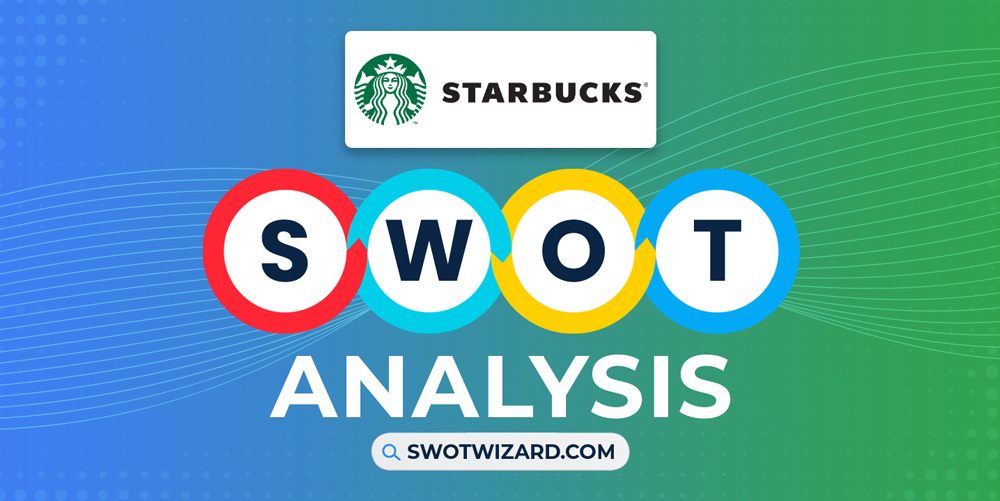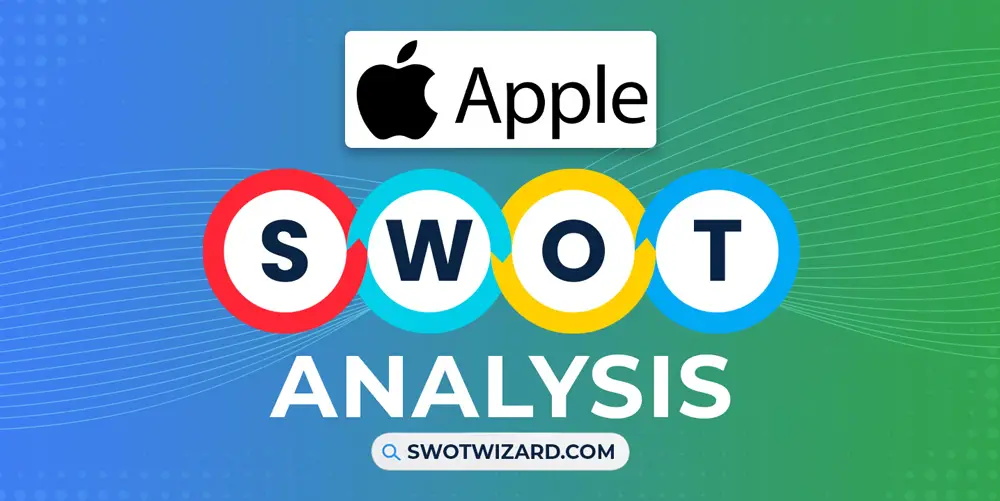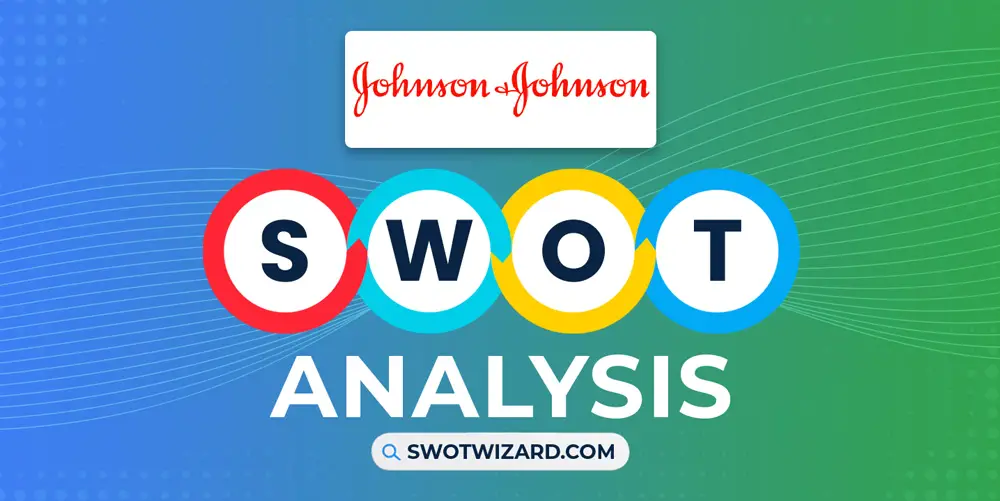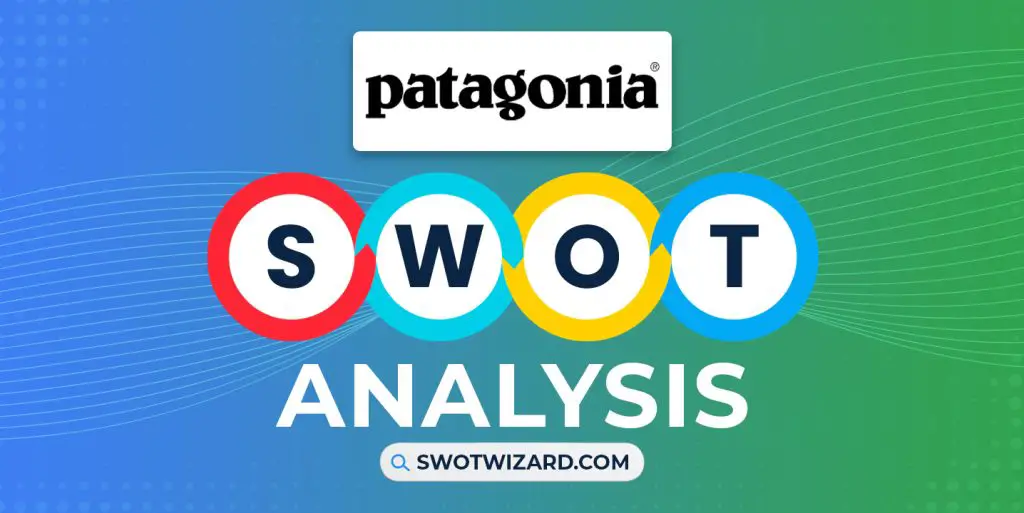Starbucks is one of the world’s most popular coffee chains and is currently the 112th company in the world by market cap. It’s the largest coffee brand in the world and arguably the trendsetter in the market. The company has changed how coffee is perceived and regularly influences coffee lovers with its marketing and product releases. So, let’s try to understand its prominence and impact through the Starbucks SWOT analysis.
Starbucks: Company Overview
| Company | Starbucks Corporation |
| Industry | Coffee Shop |
| Founded | 30 March, 1971 |
| Founder | Jerry Baldwin, Zev Siegl, Gordon Bowker |
| CEO | Laxman Narasimhan |
| Headquarter | Seattle, Washington, U.S. |
| No. of Employees | 402,000+ |
| Annual Revenue | $32.25 billion (FY 2022) |
| Website | www.starbucks.com |
Jerry Baldwin, Zev Siegl, and Gordon Bowker started Starbucks in 1971 on Pike Place Market as a coffee bean, tea, and spice shop. Howard Schultz acquired the company in 1982 and converted it into a coffee shop in 1983. From 1986 to 2000, Schultz aggressively expanded the franchise, first in Seattle and then along the West Coast. In 2022, Starbucks was reported to have 35,711 stores worldwide.
Starbucks is not considered to be the most influential coffee chain in the world. Led by CEO Laxman Narasimhan (From 20 March 2023) and Chairperson Mellody Hobson, the company now generates a revenue of $30.23 billion, and employs over 402,000 people. The company operates over 9,265 stores in the U.S. and owns 6,608 more. The company’s stock is valued at $104.43, and it has a marketing strategy that is studied by businesses to attain growth and success.
Product & Services of Starbucks
Hot and Cold Drinks | Coffee | Beverages | Pastries | Snacks | Juices
Starbucks Competitors
McDonald’s | Dunkin Donuts | Costa Coffee | Tim Hortons | Peet’s Coffee
Did You Know?
Starbucks’s automated brewing process is considered by many to be the cause of the 3rd wave of coffee in the U.S. 3rd wave coffee focused on limited, traditional production of coffee and how to bring out the flavor of each type. The 3rd wave also focused heavily on the barista’s expertise, the recipe, and the quality of the beverages.
Strengths – Starbucks SWOT Analysis
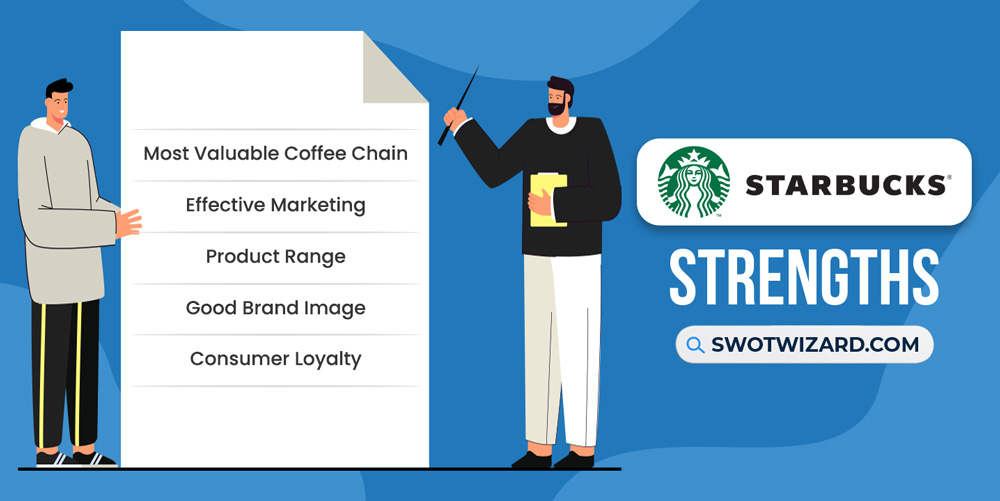
Most Valuable Coffee Chain: Starbucks is arguably the most valuable coffee chain in the world, selling over 4 million coffees each day. Starbucks was ranked 120th in the Fortune 500 ranking in 2020, and it was awarded the 303rd rank in the Forbes Global 2000 list in 2022. With a $4.39 billion profit, it has claimed the place as the premium coffee chain that competitors have to catch up to.
Effective Marketing: Starbucks is known for its clever and subtle marketing tactics. It’s part of Starbucks’ mission statement to provide consumers a 3rd place between work and home, where they can find themselves. Every chain shop sells the experience, ambiance, interactions in the shop, and coffee. The company is also known for placing its famous coffee cup intentionally within popular media, social media, and YouTube content to make its brand seem relevant in every situation.
Product Range: Starbucks has expanded its menu extensively with its growth, offering all forms of beverages and food items. Starbucks offers over 7 styles of caffeinated drinks and more than 9 kinds of non-caffeinated drinks. It offers 11 breakfast items, 31 baked goods, 12 lunch items, and over 9 snack items. The company also sells such as cold cups, tumblers, mugs, water bottles, and more.
Good Brand Image: Starbucks’ green dominant branding creates the idea that it cares about the environment, and it subtly uses shades of brown on its website, social media, and adverts to hint at its product It subtly entices the consumers to buy their products in a more open and welcoming environment. For employees, Starbucks provides a great workplace and fair recruitment, which has made them the 17th most female-friendly company.
Consumer Loyalty: Although Dunkin Donuts and McDonald’s are the most commonly used coffee shop, consumers perceive Starbucks as a coffee to reward themselves. The service and product quality give consumers a local shop feel and a sense of ownership which holds their loyalty. For those within the age group of 25-40, Starbucks serves as a point where they can transition from work to home or the opposite.
Weaknesses – Starbucks SWOT Analysis
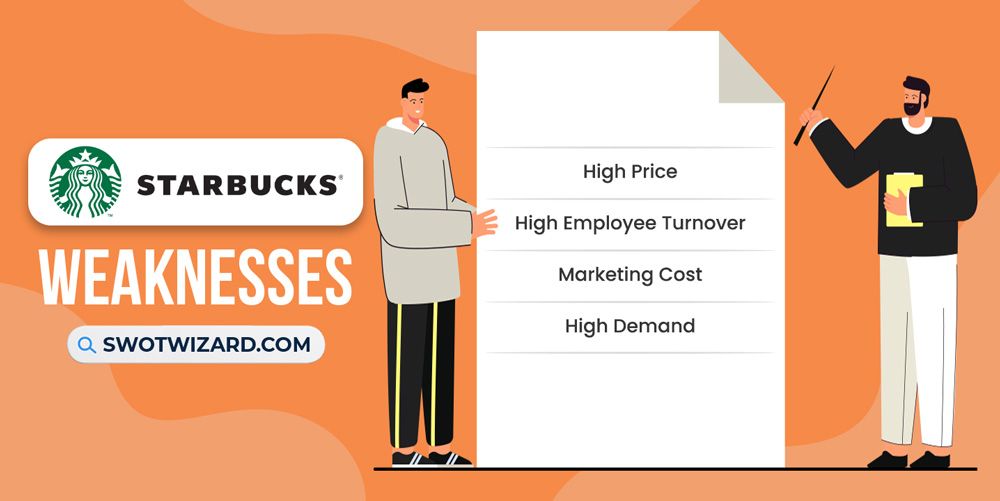
High Price: Starbucks’s Latte costs $0.45 more than its McDonald’s counterpart, and it’s 4 fluid ounces less. However, students can spend up to $300 on Starbucks per semester, while using Folger’s ground coffee would cost only $45. Starbucks marks up its products because of its running costs, resourcing, and brand image. But such high markups in a falling economy have begun to turn consumers away.
High Employee Turnover: Starbucks has been accused of providing low pay and having intense working conditions. Some locations have reported turnover rates of 140% in 2022, and cited the work environment and pay as reasons. Baristas have been alleged to be paid less per hour than what an average customer costs. With Starbucks focusing more on complicated drinks requiring intense labor and the inflation capsizing the 5% pay raise, it’s impossible for employees to remain.
Marketing Cost: Starbucks gains its consumer loyalty and brand image chiefly from its marketing. Unlike other chains, the company expends a lot of effort into the minute details of their adverts. However, its marketing cost is beginning to skyrocket past safe margins. In 2020, Starbucks spent $258.8 million on marketing, and in 2022 the cost hiked to $416.7 million.
High Demand: Starbucks has dealt with high-volume online orders before. In 2017, Starbucks chain shops had to deal with so many online orders that walk-in customers left. While this helped the company greatly during the pandemic, it can become a hectic mess to deal with now.
Opportunities – Starbucks SWOT Analysis
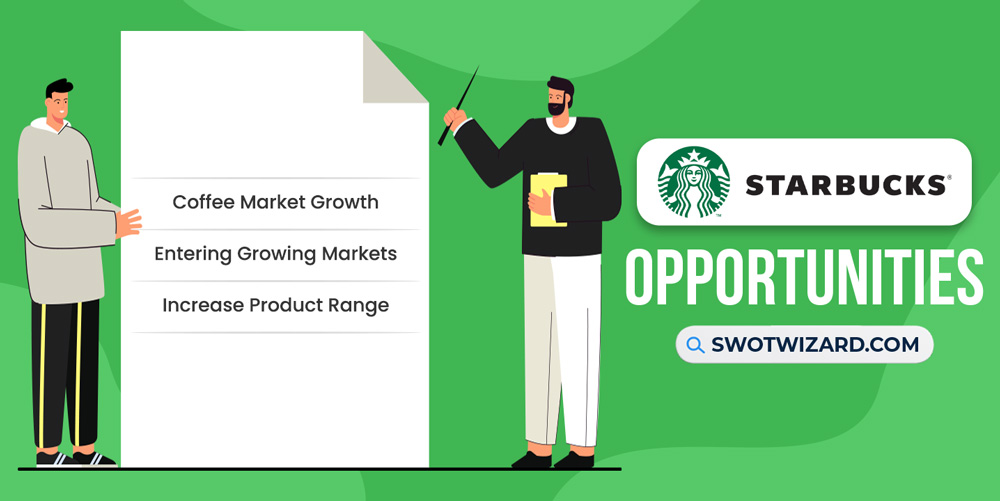
Coffee Market Growth: The global coffee market is projected to announce a Compound Annual Growth Rating of 4.65% during 2022-2027. Developed economies are expected to prefer premium-grade coffee over instant coffee. This increase in demand and change in preference is leaning heavily in Starbucks’ direction. The company can exploit this opportunity by expanding further and increasing production.
Entering Growing Markets: Within 2025, the fastest-growing coffee markets are said to emerge in Asia-Pacific. The working population in the region has displayed a craving for coffee, and many coffee shops have already developed in response. Starbucks can invade these markets and buy off local chains to acquire a larger consumer base.
Increase Product Range: Starbucks has already expanded beyond food and into Merchandise. However, it can further increase its product range in technology. The company can collaborate with technology companies to produce limited-edition smartphones and laptops. It can also sell laptops and smartphone skins for its loyalists.
Threats – Starbucks SWOT Analysis
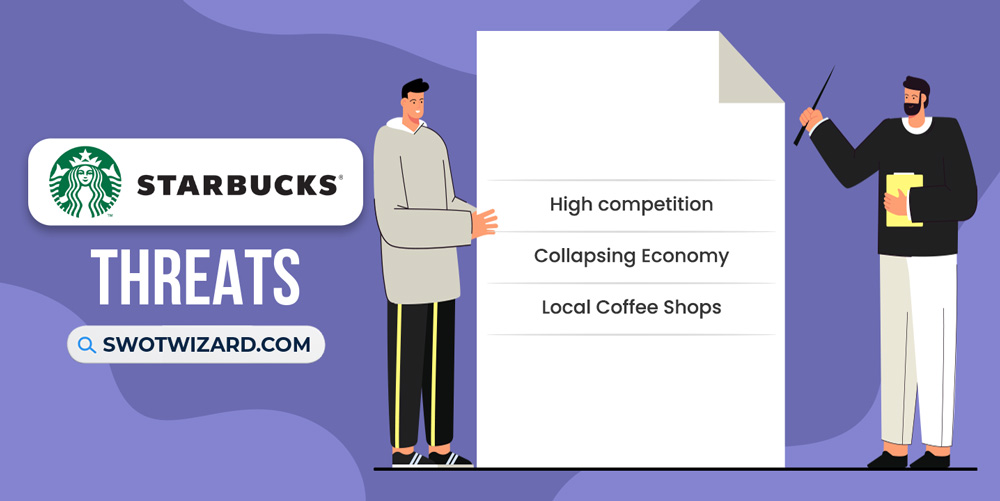
High competition: By venturing into the fast-food industry, Starbucks has gained intense competition. Also, fast food giants such as McDonald’s, Wendy’s, Cracker Barrel, Brinker, and Darden have launched similar coffee products for a cheaper price. These companies can undercut Starbucks and steal its customer base.
Collapsing Economy: The pandemic, followed by mounting global unrest, has caused the economy to suffer. This has drastically reduced the purchasing power of consumers. This can cause Starbucks to market itself more to sustain its consumer base and lose revenue in the long term.
Local Coffee Shops: Many global markets have local coffee shops with a good reputation, unique recipes, and history. They can also locally source and offer their products at a lower cost than Starbucks. This makes it significantly harder to invade these markets and win over new customers.
[Bonus Infographic] SWOT Analysis of Starbucks
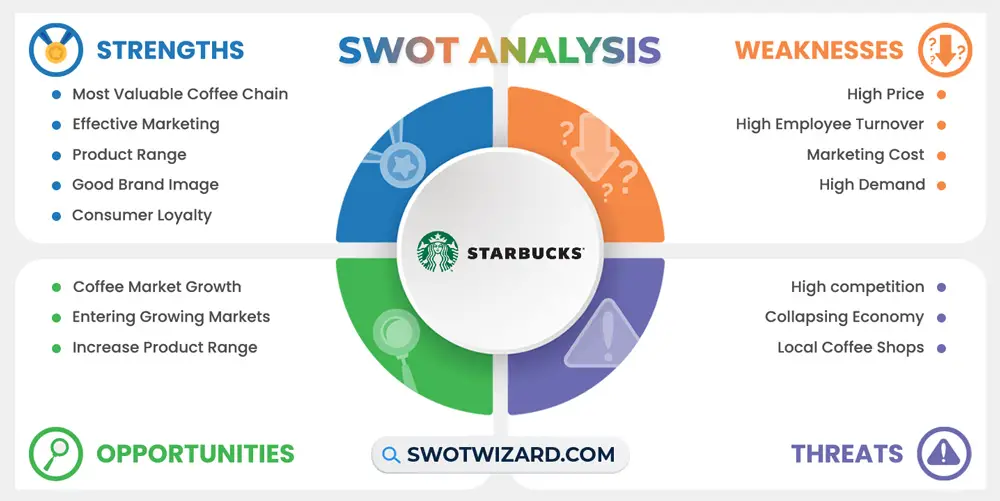
Recommendations for Starbucks
Starbucks effectively controls the U.S. coffee market, and its global presence is increasing day by day. However, Starbucks’ expansion strategy is not sustainable without making changes. It will need to consider the following changes to ensure safe growth.
- Starbucks needs to pay attention to its employee relationships. It needs to create a channel for employee complaints, suggestions, and needs. It also needs to provide real-time feedback and provide a tracking system to display sincerity.
- Starbucks needs to reduce the workload on its employees. To ensure that it doesn’t have to lower its runtime, it can hire more staff or increase pay. It can also offer higher annual increments to cover inflation-induced losses.
- The company can increase its online food delivery capacity by hiring ghost kitchens. This will reduce the cost of production and put less burden on employees.
- The company should collect suggestions and ideas from local employees in global markets. This will provide better insight than any market research and help the company expand into markets while keeping up with local trends.
- Starbucks should offer local specialties in global markets. This will familiarize the brand with consumers and attract a diverse consumer base.
Frequently Asked Questions (FAQs)
How did Starbucks get its name?
Starbucks got the name from the character Starbuck, the first mate of Pequod in “Moby-Dick.”
What’s Starbucks’ cheapest coffee order?
Starbucks’ cheapest coffee order is freshly brewed tall coffee.
Final Words on Starbucks SWOT Analysis
Starbucks has been leading the coffee industry for nearly a decade. However, the direction of the company’s growth has taken it into the fast food and merchandise industry. The competition here is much higher, and companies such as McDonald’s have a much higher market cap. If the company wants to sustain its expansion, it will have to modify its workplace and employee policies and reduce turnover.
References
- Wikipedia contributors. (n.d.). Starbucks Corporation. Wikipedia.
- Starbucks (SBUX) – Market capitalization. (n.d.). CompaniesMarketCap.
- About Us: Starbucks Coffee Company. (n.d.). Starbucks.
- Total Starbucks locations globally 2003-2022. (2022, November 28). Statista.
- Starbucks (SBUX) – Revenue. (n.d.). CompaniesMarketCap.
- Number of Starbucks stores in the U.S. 2005-2022. (2022, November 28). Statista.
- Cardello, J. (2022, October 28). Can Starbucks Compete with Third Wave Coffee?. UNINCORPORATED.
- Baertlein, L. (2015, October 30). Peet’s rides coffee’s “third wave” with stake in Intelligentsia. Reuters.
- Jordan, K. (n.d.). How Many Customers Does Starbucks Get A Day? (How Much Does The Average Customer Spend At Starbucks? + More Information). Starbmag.
- Starbucks. (n.d.). Fortune.
- MURPHY, A., & CONTRERAS, I. (2022, May 12). The Global 2000. Forbes.
- Luck, I. (2021, April 28). Starbucks Marketing Strategy — It’s Genius!. Marketing Strategy.
- Saad, N. (2019, May 6). How did that Starbucks cup end up on ‘Game of Thrones’?. Los Angeles Times.
- Menu: Starbucks Coffee Company. (n.d.). Starbucks.
- Sun, I. (n.d.). Why Starbucks Brand Image Methods are Super Effective (Starbucks Brand Analysis). Growth Hackers.
- The World’s Top Female-Friendly Companies. (2022, November 2). Forbes.
- Why People Might Choose Starbucks Coffee Over Other Brands. (2022, December 5). TheCommonsCafe.
- Stojanovic, M. (2022, February 16). 15 Starbucks Statistics for True Coffee Lovers. ComfyLiving.
- Shagnea, C. (2017, April 28). How Much Does Starbucks Really Cost You?. Spoon University.
- Jacobs, J. (n.d.). Why Is Starbucks So Expensive? (Top 10 Reasons). The Cold Wire.
- Starbucks union activist says his location has a turnover rate of 140 percent. (2022, February 17). The Hill.
- Meisenzahl, M. (2021, May 15). A Starbucks worker reveals the average customer order costs more than she makes an hour, as the coffee giant focuses on more expensive, complicated drinks. Business Insider.
- Faria, J. (2023, January 6). Starbucks Corporation’s advertising spending worldwide in the fiscal years 2011 to 2022. Statista.
- Levy, A. (2017, February 6). Starbucks Says Its Biggest Problem Is Too Much Demand. Fox Business.
- COFFEE MARKET – GROWTH, TRENDS, AND FORECASTS (2023 – 2028). (n.d.). Mordor Intelligence.
- Worldwide Coffee Industry to 2025 – Increasing Out of Home Coffee Consuming Population is Driving Growth. (2021, December 8). Cision PR Newswire.

